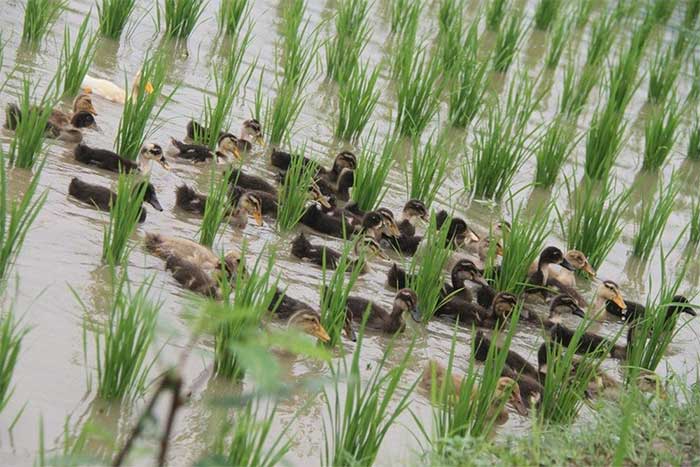Rice cultivation and animal husbandry in fields has long been a tradition in Southeast Asia.
Today, this model can meet global food demands, generate an additional $150 billion annually for producers, and improve environmental health.
Addressing Multiple Challenges
Research shows that traditional rice farming techniques in Southeast Asia, which include fish and other animal farming in rice fields, have the potential to satisfy global food needs. Additionally, this method enhances the health of both humans and the environment. However, it is rarely practiced today, with only 1% of global rice production coming from such integrated farms, despite rice being a staple food that sustains about half of the world’s population.
Integrated rice-animal farming systems offer several advantages over conventional monoculture practices. According to the American Geophysical Union (AGU), this method helps reduce 300,000 tons of nitrogen runoff and leaching, and cuts methane emissions by 190,000 tons from rice fields.
Ecologist Baojing Gu at Zhejiang University (China), the lead author of the study, stated: “The integrated rice and animal farming systems provide an innovative strategy to address many challenges faced by society today.”
These challenges include food crises, climate change, environmental pollution, and resource shortages. Ecologist Jinglan Cui (Zhejiang University), co-author of the research, shared: “Integrated farming systems produce a wider variety of foods and diverse sources of nutrition, contributing to food security.”
The research conducted by scientists Baojing Gu and Jinglan Jane Cui was published in AGU’s journal Earth’s Future. It focuses on interdisciplinary research regarding the past, present, and future of our planet and its inhabitants. The study evaluated the performance of rice and animal farming systems worldwide through the results of 155 different case studies.
According to the study, such integrated farms increase annual rice yields by 4% while reducing nitrogen runoff (by 16%) and leaching (by 13%) compared to rice monoculture. Rice-animal farms reduce methane emissions by 11% compared to rice monoculture.
Simultaneously cultivating rice and ducks and rice and shrimp is estimated to reduce methane emissions by about 40%. Meanwhile, rice-fish farming systems are estimated to increase methane emissions by 29%.
The difference in methane emissions among farming systems may be due to the oxygen concentration present in each system, with methane emissions rising as oxygen levels decrease.
Fish swimming in the fields consume oxygen in the system, leading to higher methane emissions. Ducks and shrimp, on the other hand, introduce oxygen into the system by burrowing and aerating the soil in rice fields, reducing methane emissions.
Previous studies have found that integrating rice cultivation with animal husbandry enhances land-use efficiency. Additionally, it reduces the need for commercial fertilizers due to the nutrient-rich manure from animals. The use of pesticides is also limited as these animals consume many insects and weeds.
Economic Benefits of Widespread Adoption

Simultaneous rice and duck farming in Nepal.
According to the research, 87% of existing monoculture rice farms, totaling 143 million hectares worldwide, are estimated to be suitable for integrated rice-animal farming based on their climate.
If all suitable lands were used for simultaneous rice-animal cultivation, these farms could produce over 140 million tons of animal protein annually, surpassing the current global aquaculture production of just over 100 million tons per year.
The global adoption of rice-animal integrated farming systems is estimated to generate an additional revenue of $152 to $171 billion for producers annually. However, expected profits will vary by country and depend on the area of land suitable for this type of farming.
Countries in Asia are expected to benefit the most from this farming method, where more suitable land is available. Producers in China and India are estimated to gain an additional $34.8 billion to $52.8 billion each year, while producers in Indonesia, Bangladesh, and Thailand could see an increase of $10.4 billion to $18.9 billion annually by switching to integrated rice-animal farming.
Countries in other regions of the world have climates suitable for rice-animal farming, but very few farms of this type have been established.
However, according to the study, these countries could also benefit from adopting this method. Countries like the United States and Brazil could earn an additional $1.4 to $2.4 billion annually if they implement integrated rice-animal farming systems.
Despite the potential benefits, the implementation of this farming method faces challenges if it is to be developed on a global scale.
According to author Jinglan Jane Cui, the reasons are that it requires specific technologies; resources such as capital, labor, infrastructure, and market networks; and it also threatens national policies that promote rice monoculture.
Furthermore, existing agricultural policies that support rice monoculture may create many barriers to the adoption of integrated rice-animal farming models in various countries.




















































